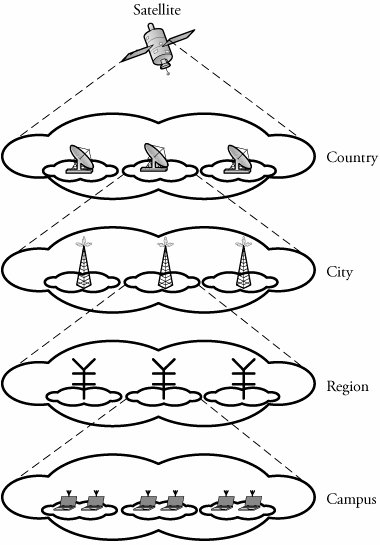Section 6.1. Infrastructure of Wireless Networks
6.1. Infrastructure of Wireless NetworksFigure 6.1 shows wireless communication systems at all levels. Satellite systems can provide a widespread global coverage for voice, data, and video applications. A satellite orbits the earth while interfacing between a receiver/transmitter pair. The interfacing facilitates the transmission of data to long-distance destinations. Satellite systems are classified according to the orbit distance from the earth:
Figure 6.1. Wireless communication systems, from satellite to LAN Similar to wired networks, wireless networks are hierarchical. However, wireless networks are characterized by limited resources from the perspective of frequency range and available bandwidth. The available bandwidth often varies with time. Wireless networks must be able to adapt to the changing network topology. Wireless network topologies are classified into three main groups:
The hierarchical architecture acts as a spanning tree and normally covers a large geographical area. The lowest layer of the hierarchy normally represents indoor systems that cover very small areas. The next layer in the hierarchy consists of cellular systems. This hierarchy can be extended to global coverage. The hierarchical topology is ideally suited for large networks. In a star topology, as explained in Chapter 5, nodes are connected to a central hub. Thus, the entire traffic from nodes flows through this central hub. Star networks are used in cellular and paging systems. Peer-to-peer networks are characterized by pairs of nodes and are normally used in military applications. In these networks, nodes are self-configuring , and various tasks are evenly distributed among nodes. Peer-to-peer networks are multihop networks; a node may use multiple hops to communicate with another node. These networks normally have multiple paths between each two nodes to route around link failures. |
EAN: 2147483647
Pages: 211
